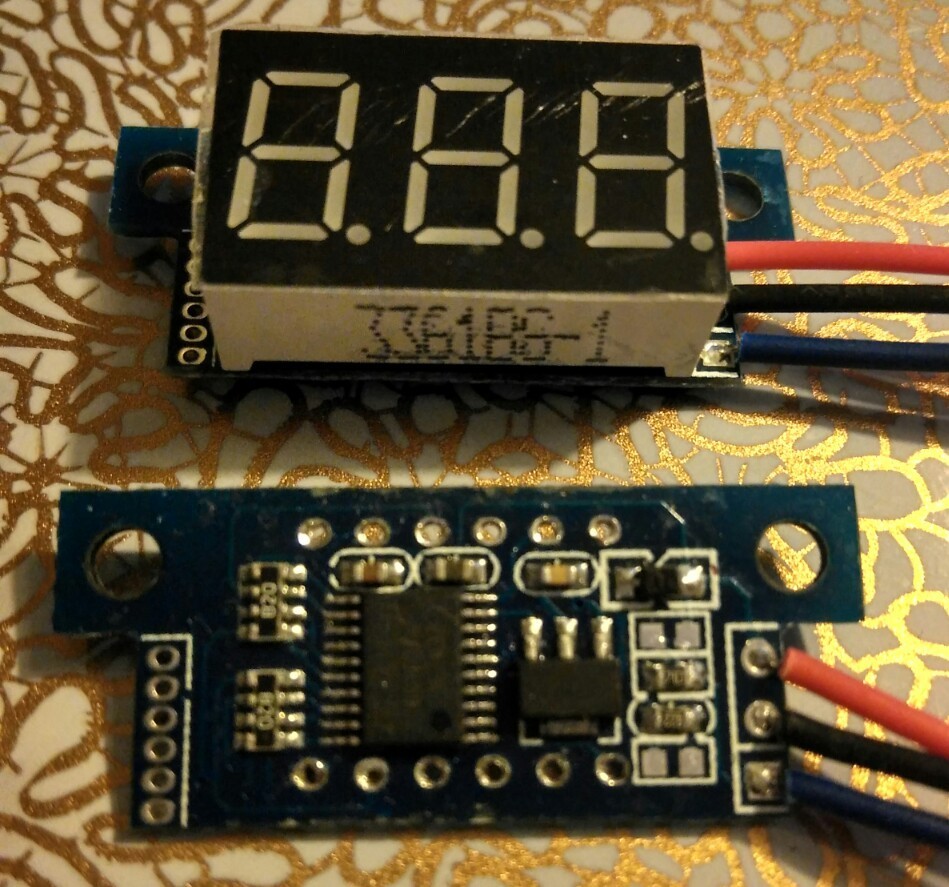After a day filled with business meetings | didn't want to risk killing the DC/DC converter for good, and I decided to look a little closer at one of the new arrivals from China, small and cheap voltmeter ($1.12 including shipping).
Repetitio non placet they say, but this voltmeter turned out to be really nice:

The LED display 3361BS is "0.36", red, common anode". The internal supply voltage is a bit unusual (3.0V), but otherwise the module is very hackable.
The 6 pads with 1.27mm pitch to the left are connected to the following signals:
1 SWIM (7S-LED segment D) 2 TxD 3 RxD 4 NRST 5 +Ub 6 GNDThe STM8S003F3P6 pins are assigned as follows:
| STM8S003F3P6 | assigned to | STM8S003F3P6 | assigned to |
| 1 PD4 | 7S-6 (NC!) | 20 PD3 | 7S-5 G |
| 2 PD5 | Pad2 TxD | 19 PD2 | 7S-4 C |
| 3 PD6 | Pad3 RxD | 18 PD1/SWIM | 7S-3 DP, Pad1 SWIM |
| 4 NRST | Pad4 NRST | 17 PC7 | 7S-2 D |
| 5 PA1 | 7S-9 Digit 2 | 16 PC6 | 7S-1 E |
| 6 PA2 | (7S-9 Digit 2) | 15 PC5 | 7S-7 B |
| 7 Vss | GND | 14 PC4/Ain2 | TP (535k-Ain-8k26-GND) |
| 8 Vcap | C | 13 PC3 | 7S-12 Digit 1 |
| 9 Vdd | +3.0V | 12 PB4 | 7S-10 F |
| 10 PA3 | 7S-8 Digit 3 | 11 PB5 | 7S-11 A |
I guess that the designer was bored by making yet another cheap Chinese
voltmeter, and he decided to make a hackable voltmeter instead. If not, why would one expose not only SWIM/NRST but also RxD and
TxD? Why route a spare GPIO to the (unpopulated) NC pad of the LED
display?
Hat-tip to China!
 Thomas
Thomas
Discussions
Become a member
In order to follow projects & hackers or give likes
Already a member?you need to create an account.
alternative :
https://www.aliexpress.com/item/Direct-Current-DC0-200V-0-36Inch-Red-LED-Digital-Display-Voltmeter-Panel/32250071130.html
Are you sure? yes | no
Anders, right, that's the same type of voltmeter. The price is very good.
Are you sure? yes | no
Hm, they too have to program it somehow, so a port like this would make sense, if they don't get those chips pre-programmed, right? But good to know there are STM8s under there (probably) :)
Are you sure? yes | no
Some of the boards seem to be produced with pre-programmed controllers. Some "DC/DC converter with voltmeter" boards are in this category.
On the other hand, access to GND and to PD1/SWIM is sufficient under certain (easily met) conditions for ICP. There is a family of "relay boards" that might be interesting, but PD1/SWIM appears to be unused, and that's why I didn't buy one for this little project.
Are you sure? yes | no
Just make sure it is not this one as it has a different microcontroller with 14 pins with no spares.
https://hackaday.io/project/7700-collection-of-misc-small-project/log/30822-cheap-voltmeter-from-china
Are you sure? yes | no
You're right, you can never be sure what you get, but in this case pads labeled RxD and TxD were easy to spot.
I ordered here:
https://www.aliexpress.com/item/New-LED-Digital-Display-Voltmeter-Panel-DC0-200V-0-36Inch-Direct-Current-Red-high-quality-free/32565027508.html
Are you sure? yes | no
here is another one:
https://www.aliexpress.com/item/Direct-Current-DC0-200V-0-36Inch-Red-LED-Digital-Display-Voltmeter-Panel/32250071130.html
Are you sure? yes | no